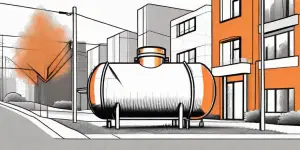An oil burner is an essential part of many homes, providing heat during the chilly winter months. However, like any mechanical system, it can sometimes encounter issues that need to be addressed. One common problem that homeowners may face is a tripped oil furnace button. In this article, we will discuss the function of the oil furnace button, why it may trip, safety precautions before resetting, and a step-by-step guide on how to reset it. We will also cover troubleshooting tips and the importance of regular maintenance for optimal performance.
See Also: Getting the Most Out of Your Oil Burner: Tune-Up and Vacuum Services
Understanding the Function of an Oil Furnace Button
An oil burner button, also known as a reset button or safety switch, is a small red button located on the burner motor or control panel. Its primary function is to monitor and control the burner ‘s operation. When the button is triggered, it shuts off the burner to prevent any potential damage or hazardous situations.
But what exactly happens when you press that little red button? Let’s dive deeper into the role of the reset button in an oil furnace.
The Role of the Reset Button in an Oil Furnace
The reset button acts as a safety feature, designed to protect the burner from overheating or other malfunctions. When the burner detects an issue, such as a blocked flue or clogged filter, it shuts down and activates the reset button. This interruption prevents the burner from causing further damage and allows the homeowner to address the problem before resuming normal operation.
Imagine this scenario: it’s a chilly winter night, and you’re relying on your oil furnace to keep your home warm and cozy. Suddenly, you notice that the furnace has stopped working. You go to the basement, where the furnace is located, and find that the reset button has been triggered. This simple button has saved you from potential disaster by shutting down the furnace and preventing any further damage.
Now, let’s explore some of the reasons why the reset button may trip.
Why the Reset Button May Trip
Several factors can cause an oil furnace button to trip. The most common reason is a blocked or dirty air filter, which restricts airflow and can cause the furnace to overheat. Over time, dust, debris, and other particles accumulate in the filter, reducing its efficiency. This increased resistance to airflow forces the furnace to work harder, leading to overheating and triggering the reset button.
Another potential cause of the reset button tripping is a malfunctioning motor. The motor is responsible for powering the fan and other components of the furnace. If the motor is not functioning properly, it can cause the furnace to overheat and activate the reset button as a safety measure.
Faulty wiring can also be a culprit. Over time, the electrical connections in the furnace may become loose or damaged, leading to irregularities in the system. These irregularities can trigger the reset button, shutting down the furnace to prevent any electrical hazards.
Lastly, a problem with the ignition system can cause the reset button to trip. The ignition system is responsible for igniting the oil and starting the combustion process. If there is an issue with the ignition system, such as a faulty sensor or a clogged fuel line, the furnace may not ignite properly, leading to a shutdown and activation of the reset button.
By identifying the underlying issue that caused the reset button to trip, you can prevent the button from tripping again in the future. Regular maintenance, such as cleaning or replacing the air filter, inspecting the motor, and ensuring proper electrical connections, can help keep your oil furnace running smoothly and minimize the chances of the reset button being triggered.
So, the next time you come across that little red button on your oil furnace, remember its crucial role in keeping your home safe and warm. It’s not just a button; it’s a guardian, protecting your furnace from potential harm.
Safety Precautions Before Resetting Your Oil Furnace
Before attempting to reset your oil furnace button, it’s crucial to prioritize safety. Follow these necessary precautions to protect yourself and prevent any accidents:
When it comes to maintaining and troubleshooting your oil furnace, safety should always be the top priority. Taking the necessary precautions ensures that you can work on your furnace with confidence, minimizing the risk of injury or damage.
Necessary Tools and Protective Gear
Ensure you have the required tools and protective gear before starting any work on your oil furnace. This may include a screwdriver, flashlight, gloves, and safety goggles. These items will help you safely handle and inspect the furnace components.
Having the right tools and protective gear not only makes the job easier but also provides an added layer of safety. The screwdriver allows you to access and manipulate various parts of the furnace, while the flashlight helps you see clearly in dark or hard-to-reach areas. Gloves and safety goggles protect your hands and eyes from potential hazards such as sharp edges or debris.
Turning Off the Power Supply
Before resetting the oil furnace button, turn off the power supply to the furnace. Locate the main electrical switch or circuit breaker for the furnace and switch it off to avoid any potential electrical shocks. Safety should always be the top priority.
Electricity and oil furnaces don’t mix well, so it’s crucial to disconnect the power supply before working on the furnace. By turning off the main electrical switch or circuit breaker, you eliminate the risk of accidental electrocution. This step ensures that you can safely handle the furnace components without any electrical hazards.
Remember, even if the furnace is not currently running, there may still be residual electrical energy present. Therefore, it’s essential to take this precautionary step to protect yourself and prevent any potential accidents.
Step-by-Step Guide to Resetting Your Oil Furnace Button
Resetting your oil furnace button can often resolve minor issues and get your furnace running again. Follow these steps to reset the button correctly:
Locating the Reset Button
1. Begin by carefully locating the reset button on your oil furnace. It is typically a small red button, often labeled “RESET” or “RESTART,” located on the burner motor or control panel. Refer to your furnace’s user manual if you are having trouble finding it.
2. Once you have found the reset button, identify any other nearby buttons, switches, or knobs that may need to be adjusted during the reset process, such as the power switch or temperature controls.
3. It is important to understand the significance of the reset button. This button is designed to trip or shut off the furnace when it detects a problem, such as a blocked flue or overheating. Resetting the button allows the furnace to start fresh and attempt to operate normally again.
Resetting the Button Correctly
1. After ensuring the power supply is turned off and you have located the reset button, press and hold it down for about 30 seconds. This allows the furnace’s internal safety mechanisms to reset.
2. While holding the reset button, it may be helpful to visualize the intricate network of components within the furnace. The reset button serves as a crucial link in this network, ensuring the proper functioning of the entire system.
3. Once the time has passed, release the reset button and wait for a few minutes. This allows the furnace to reset fully and stabilize before attempting to turn it back on.
4. During this waiting period, take a moment to appreciate the complexity of the furnace’s inner workings. From the combustion chamber to the heat exchanger, each component plays a vital role in providing warmth and comfort to your home.
5. After the waiting period, turn the power supply back on and set the thermostat to a desired temperature. If the furnace starts up and operates normally, the reset was successful. However, if the furnace fails to start, or the button trips again, it may be necessary to seek professional assistance.
6. Remember, your oil furnace is a sophisticated piece of equipment that requires regular maintenance and care. In addition to resetting the button, it is important to schedule annual inspections and cleanings to ensure optimal performance and longevity.
7. By following these steps and gaining a deeper understanding of your oil furnace, you can confidently troubleshoot minor issues and keep your home warm and cozy throughout the winter months.
Troubleshooting After Resetting the Oil Furnace Button
Even after successfully resetting the oil furnace button, there may still be issues that need attention. It’s important to understand the troubleshooting steps to ensure the furnace is running efficiently and effectively. Let’s explore some additional details to consider:
What to Do if the Furnace Doesn’t Start
If the furnace fails to start after resetting the button, there are a few more troubleshooting steps you can take. First, check the thermostat settings to ensure it is set to “heat” and the desired temperature. Sometimes, a simple adjustment to the thermostat can solve the problem. Next, inspect the fuel supply to the furnace to ensure it is not empty or blocked. A lack of fuel can prevent the furnace from starting properly. If these steps do not resolve the issue, it may be necessary to contact a professional HVAC technician for further diagnosis and repairs.
When reaching out to a professional, it’s important to provide them with as much information as possible. Let them know that you have already reset the oil furnace button and describe any other troubleshooting steps you have taken. This will help the technician understand the situation better and expedite the repair process.
When to Call a Professional
While resetting the oil furnace button can solve minor issues, there are situations where professional assistance is necessary. If the furnace repeatedly trips the reset button, emits strange noises, or produces unusual odors, it’s best to call a licensed HVAC technician. These symptoms could indicate more significant problems that require expert attention.
When you contact a professional, make sure to provide them with a detailed description of the issue and any relevant observations. This will assist them in identifying the root cause of the problem and implementing the appropriate solution.
Remember, HVAC technicians have the knowledge and experience to diagnose and repair complex problems safely. They are equipped with specialized tools and training to handle various furnace issues effectively. By seeking professional assistance, you can ensure the longevity and optimal performance of your oil furnace.
Maintaining Your Oil Furnace for Optimal Performance
To ensure your oil furnace operates efficiently and provides reliable heat, regular maintenance is essential. Consider these important maintenance tasks:
Regular Cleaning and Inspection
Inspect and clean your furnace’s air filters regularly, ideally every month or according to the manufacturer’s recommendations. Replace or clean dirty filters to prevent them from obstructing airflow and causing the furnace to overheat. Additionally, inspect the burner motor, ignition system, and flue for any signs of damage or debris buildup.
Scheduling Professional Maintenance
It’s advisable to schedule an annual professional maintenance service for your oil furnace. During this service, a qualified technician will inspect and clean the furnace thoroughly, identify any potential issues, and perform necessary repairs or adjustments. Regular professional maintenance helps prolong the lifespan of your furnace and ensures optimal performance throughout the heating season.
By understanding the function of the oil furnace button, following proper safety precautions, and knowing how to reset and troubleshoot your furnace, you can keep your heating system operating smoothly. Regular maintenance and professional servicing will also contribute to the longevity and efficiency of your oil furnace, providing dependable heat for years to come. Stay warm and worry-free during the winter months with a well-maintained and properly reset oil furnace button.



